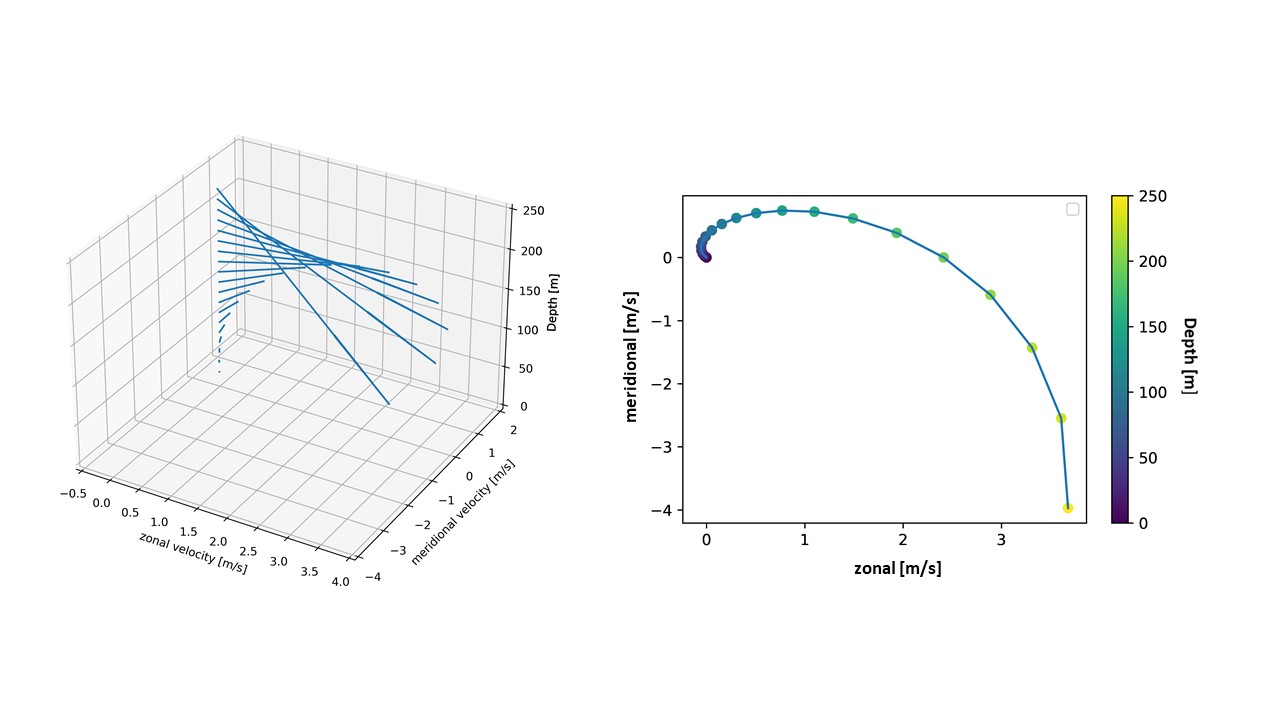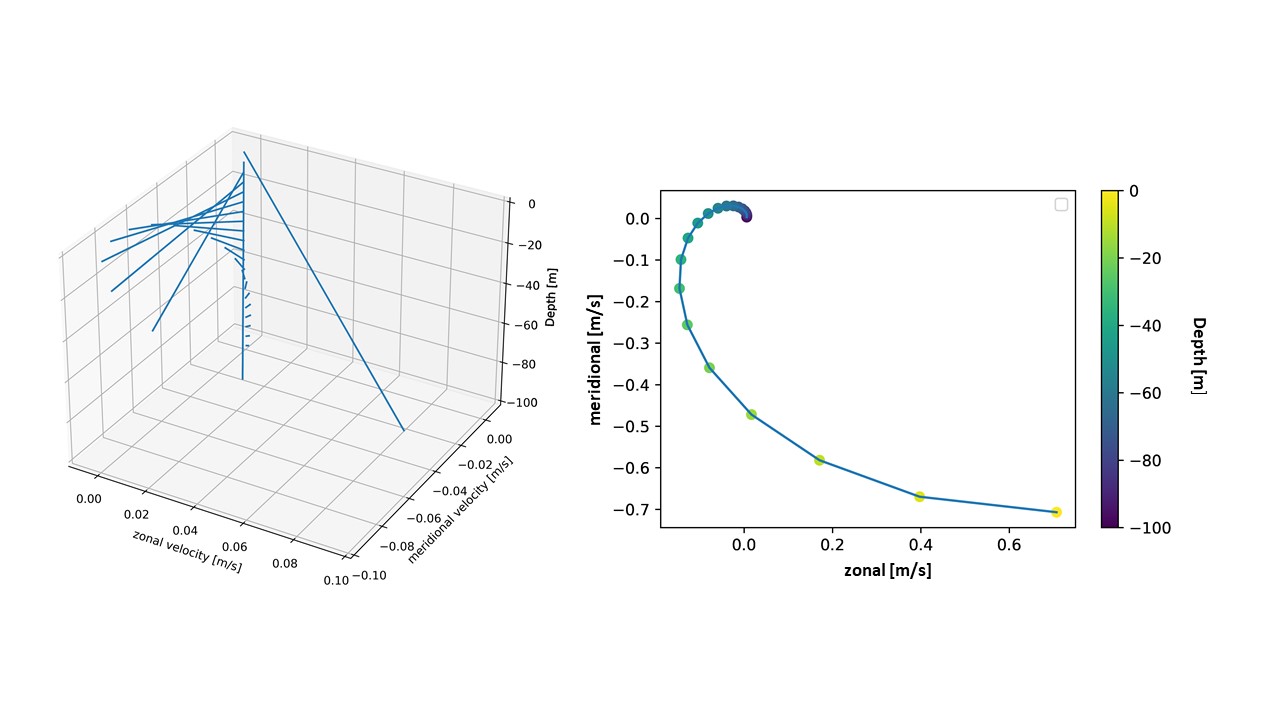Ekman spiral on:
[Wikipedia]
[Google]
[Amazon]
The oceanic, wind driven Ekman spiral is the result of a force balance created by a
 In order to derive the properties of an Ekman spiral a look is taken at a uniform, horizontal geostrophic interior flow in a homogeneous fluid. This flow will by denoted by , where the two components are constant because of uniformity. Another result of this property is that the horizontal gradients will equal zero. As a result, the
In order to derive the properties of an Ekman spiral a look is taken at a uniform, horizontal geostrophic interior flow in a homogeneous fluid. This flow will by denoted by , where the two components are constant because of uniformity. Another result of this property is that the horizontal gradients will equal zero. As a result, the
 The solution for the flow forming the bottom Ekman spiral was a result of the
The solution for the flow forming the bottom Ekman spiral was a result of the
shear stress
Shear stress, often denoted by ( Greek: tau), is the component of stress coplanar with a material cross section. It arises from the shear force, the component of force vector parallel to the material cross section. '' Normal stress'', on ...
force, Coriolis force
In physics, the Coriolis force is an inertial or fictitious force that acts on objects in motion within a frame of reference that rotates with respect to an inertial frame. In a reference frame with clockwise rotation, the force acts to the ...
and the water drag. This force balance gives a resulting current of the water different from the winds. In the ocean, there are two places where the Ekman spiral can be observed. At the surface of the ocean, the shear stress force corresponds with the wind stress force. At the bottom of the ocean, the shear stress
Shear stress, often denoted by ( Greek: tau), is the component of stress coplanar with a material cross section. It arises from the shear force, the component of force vector parallel to the material cross section. '' Normal stress'', on ...
force is created by friction
Friction is the force resisting the relative motion of solid surfaces, fluid layers, and material elements sliding against each other. There are several types of friction:
*Dry friction is a force that opposes the relative lateral motion of ...
with the ocean floor. This phenomenon was first observed at the surface by the Norwegian oceanographer Fridtjof Nansen
Fridtjof Wedel-Jarlsberg Nansen (; 10 October 186113 May 1930) was a Norwegian polymath and Nobel Peace Prize laureate. He gained prominence at various points in his life as an explorer, scientist, diplomat, and humanitarian. He led the team t ...
during his Fram expedition. He noticed that icebergs did not drift in the same direction as the wind. His student, the Swedish oceanographer Vagn Walfrid Ekman, was the first person to physically explain this process.
Bottom Ekman Spiral
 In order to derive the properties of an Ekman spiral a look is taken at a uniform, horizontal geostrophic interior flow in a homogeneous fluid. This flow will by denoted by , where the two components are constant because of uniformity. Another result of this property is that the horizontal gradients will equal zero. As a result, the
In order to derive the properties of an Ekman spiral a look is taken at a uniform, horizontal geostrophic interior flow in a homogeneous fluid. This flow will by denoted by , where the two components are constant because of uniformity. Another result of this property is that the horizontal gradients will equal zero. As a result, the continuity equation
A continuity equation or transport equation is an equation that describes the transport of some quantity. It is particularly simple and powerful when applied to a conserved quantity, but it can be generalized to apply to any extensive quantity. ...
will yield, . Note that the concerning interior flow is horizontal, so at all depths, even in the boundary layers. In this case, the Navier-Stokes momentum equations, governing geophysical motion can now be reduced to:
:
Where is the Coriolis parameter, the fluid density
Density (volumetric mass density or specific mass) is the substance's mass per unit of volume. The symbol most often used for density is ''ρ'' (the lower case Greek letter rho), although the Latin letter ''D'' can also be used. Mathematicall ...
and the eddy viscosity, which are all taken as a constant here for simplicity. These parameters have a small variance on the scale of an Ekman spiral, thus this approximation will hold. A uniform flow requires a uniformly varying pressure gradient. When substituting the flow components of the interior flow, and , in the equations above, the following is obtained:
:
Using the last of the three equations at the top of this section, yields that the pressure is independent of depth.
:
and will suffice as a solution to the differential equations above. After substitution of these possible solutions in the same equations, will follow. Now, has the following possible outcomes:
:
Because of the no-slip condition at the bottom and the constant interior flow for , coefficients and can be determined. In the end, this will lead to the following solution for :
:
Here, . Note that the velocity vector will approach the values of the interior flow, when the takes the order of . This is the reason why is defined as the thickness of the Ekman layer. A number of important properties of the Ekman spiral will follow from this solution:
*When , it appears that the flow has a transverse component with respect to the interior flow, which differs 45 degrees to the left on the northern hemisphere
The Northern Hemisphere is the half of Earth that is north of the Equator. For other planets in the Solar System, north is defined as being in the same celestial hemisphere relative to the invariable plane of the solar system as Earth's Nort ...
, , and 45 degrees to the right on the southern hemisphere, . Note that, in this case, the angle between this flow and the interior flow is at its maximum. It will decrease for increasing .
*When takes the value of , the resulting flow is in line with the interior flow, but will be increased with , with respect to the interior flow.
*For higher values of , there will be a minimal transverse component in the other direction as before. The exponential term will go to zero for , resulting in . Because of these properties, the velocity vector of the flow as a function of depth will look like a spiral.
Surface Ekman Spiral
 The solution for the flow forming the bottom Ekman spiral was a result of the
The solution for the flow forming the bottom Ekman spiral was a result of the shear stress
Shear stress, often denoted by ( Greek: tau), is the component of stress coplanar with a material cross section. It arises from the shear force, the component of force vector parallel to the material cross section. '' Normal stress'', on ...
exerted on the flow by the bottom. Logically, wherever shear stress
Shear stress, often denoted by ( Greek: tau), is the component of stress coplanar with a material cross section. It arises from the shear force, the component of force vector parallel to the material cross section. '' Normal stress'', on ...
can be exerted on a flow, Ekman spirals will form. This is the case at the air-water interface, because of wind. A situation is considered where a wind stress is exerted along a water-surface with an interior flow beneath. Again, the flow is uniform, has a geostrophic interior and is homogeneous fluid. The equations of motion for a geostrophic flow, which are the same as stated in the bottom spiral section, can be reduced to:
:
The boundary conditions for this case are as follows:
* Surface : and
* Towards interior : and
With these conditions, the solution can be determined:
:
Some differences with respect to the bottom Ekman spiral emerge. The deviation from the interior flow is exclusively dependent on the wind stress and not on the interior flow. Whereas in the case of the bottom Ekman spiral, the deviation is determined by the interior flow. The wind-driven component of the flow is inversely proportional with respect to the Ekman-layer thickness . So if the layer thickness is small, because of a small viscosity of the fluid for example, this component could be very large. At last, the flow at the surface is 45 degrees to the right on the northern hemisphere
The Northern Hemisphere is the half of Earth that is north of the Equator. For other planets in the Solar System, north is defined as being in the same celestial hemisphere relative to the invariable plane of the solar system as Earth's Nort ...
and 45 degrees to the left on the southern hemisphere with respect to the wind-direction. In case of the bottom Ekman spiral, this is the other way around.
Observations
The equations and assumptions above are not representative for the actual observations of the Ekman spiral. The differences between the theory and the observations are that the angle is between 5-20 degrees instead of the 45 degrees as expected and that the Ekman layer depth and thus the Ekman spiral is less deep than expected. There are three main factors which contribute to the reason why this is, stratification,turbulence
In fluid dynamics, turbulence or turbulent flow is fluid motion characterized by chaotic changes in pressure and flow velocity. It is in contrast to a laminar flow, which occurs when a fluid flows in parallel layers, with no disruption between ...
and horizontal gradients. Other less important factors which play a role in this are the Stokes drift, waves
Waves most often refers to:
* Waves, oscillations accompanied by a transfer of energy that travel through space or mass.
* Wind waves, surface waves that occur on the free surface of bodies of water.
Waves may also refer to:
Music
*Waves (ban ...
and the Stokes-Coriolis force. Jeff A. Polton, David M. Lewis, and Stephen E. Belcher, 01 Apr 2005: The Role of Wave-Induced Coriolis–Stokes Forcing on the Wind-Driven Mixed Layer. Journal of Physical Oceanography, Volume 35: Issue 4, 444–457
References
{{Reflist Oceanography Fluid dynamics